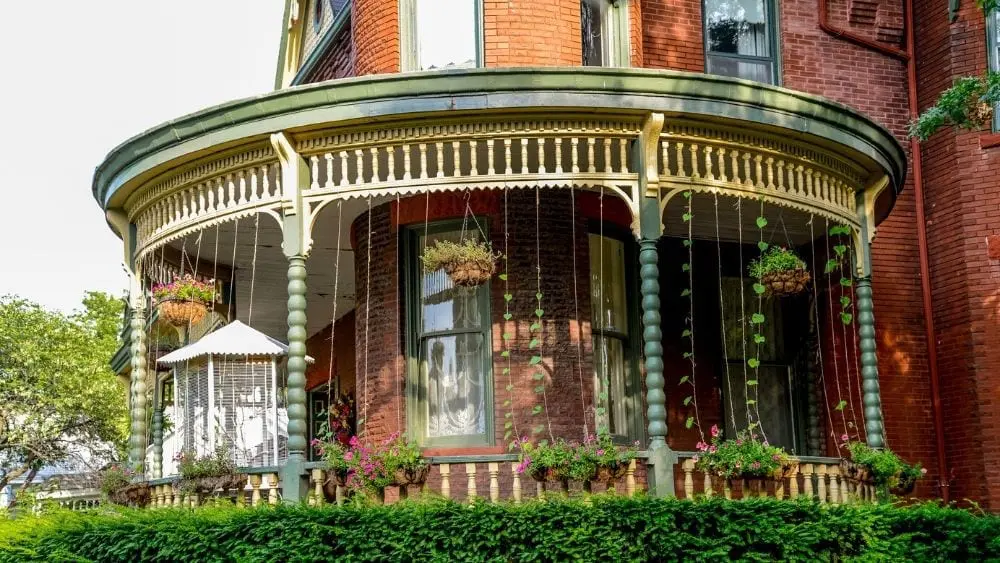
Ask most people what a Victorian home looks like and they’ll describe either a classic dollhouse or a haunted house. They’re not wrong. The ornate detailing most associated with the Victorian style can look equal amounts delicate and beautiful or sinister and forbidding depending on the lighting and circumstances. But Victorian homes are more than just fancy or imposing ornamentation — they’re a collective of many different designs pulled from many influences.
The History of Victorian Homes
Victorian architecture is a reflection of the time in which these homes first came about: the Victorian Era, which denotes Queen Victoria’s reign in England from 1837 to 1901. (The American Victorian period of home design is considered to range from 1840 to 1900.) This time period also corresponds to the Industrial Revolution. Suddenly, building materials could be easily moved from place to place via the railroads and could be mass-produced due to the rise of factories and assembly lines. Materials that were hard to come by in the past became more affordable and more accessible. Architects took full advantage of these changes to add liberal amounts of ornamentation and detailing to home designs, along with their own creative flourishes.
This over-the-top approach was completely in line with the ideals of the time, which valued form and beauty over function and practicality along with a tendency to embrace an excess of everything. This was most easily observed in the layers and layers of clothing that went into a woman’s daily ensemble, but also in the overly detailed styling of homes — both inside and out. The wealthier you were, the more ornate and excessive your belongings.
The end result of this desire for excess and easy access to materials was several different styles of Victorian homes. Grant Marani, a partner at Robert A.M. Stern Architects in New York City, explains: “Victorian means different things to different people.” He adds that the styles that are most strongly associated with this time period “emphasize verticality, decoration and a mix of materials and colors.”
Elements of Victorian Homes
Victorian homes have their foundation in Gothic architecture but beyond that, anything goes! You may see turrets, balustrades, dormers, scrollwork, spindles, stained glass … sometimes all on one house. Home designs were influenced by architecture from numerous countries including Italy, France, Egypt and England. Despite the variation in Victorian home designs, several architectural elements primarily define the exterior style:
Multiple Stories
Victorian homes are large and imposing, typically two or three stories in height.
Vertical Elements
Tall windows, columns, towers and ornamentation that draw the eye up are classic Victorian features.
Wood or Stone Exteriors
Victorian homes feature wood siding, but some styles like Italianate and Second Empire feature stone or brick.
Complicated Shapes
Victorian homes can be asymmetrical in shape. Rather than being boxy, they often have many wings, bays, towers and cupolas going in many different directions.
Decorative Trim
Almost any style of Victorian home will have elaborately decorative wood or metal trim work.
Steep Roofs
Victorian homes, in general, have multi-gabled roofs that have a steep pitch, though some styles like the Italianate, have roofs that are more sloping or flat.
Porches
What would a Victorian home be without a wraparound porch? Nearly all styles have a large porch on the lower level; some also have small balconies on upper levels. The porches are often embellished with ornamental spindles and brackets.
Vibrant Colors
Unlike homes of earlier time periods, Victorian homes are often painted in bright colors.
Victorian homes are no less complicated inside. Decorative woodwork, nooks and crannies, built-ins, high ceilings and ornate staircases are common.
Victorian Home Styles
Beyond the common design elements, Victorian homes come in a range of architectural styles:
Gothic Revival
Gothic Revival homes draw on medieval architecture, particularly their use of towers and arches. This is the classic haunted house look: tall and imposing, steeply pitched roofs with turrets, Gothic arches and wood or metal ornamentation to complete the look.
Queen Anne
The Queen Anne is perhaps the most well known of the Victorian home styles: elaborately designed, brightly colored, asymmetrical, two or three (or more) stories tall, with steeply pitched roofs and large wraparound porches. Ornate trim work and plenty of accent colors have earned this style the nickname “gingerbread house.”
Some Queen Annes have octagonal towers or turrets and ornate bay windows. If you can picture the row of “Painted Ladies” in San Francisco, you know what a Queen Anne looks like.
Italianate
Drawing inspiration from 16th-century Italian villas, Italianate homes feature a surprisingly simple structure: a rectangular house with a low sloping or flat roof with overhanging eaves. Tall, thin windows, rounded at the top, and square towers or cupolas are very common while columns, ornate cornices and heavy brackets complete the look.
Second Empire or Mansard
These homes have a French influence, tracing back to the time of Napoleon III in the mid- to late 19th century. They are very similar to the Italianate style, featuring rectangular or square bases and strong vertical elements, but they have high, double-pitched mansard roofs (four sloping sides, each of which becomes steeper halfway down) instead of flat roofs.
Stick Eastlake
As you can imagine, Stick Eastlake homes are made mostly of wood: wood framing, wood siding, wood shingles, wood details and wood spindles. The style gets its name from the stick-work details found throughout the home. Wood is used to mimic Tudor style timbers and add elaborate patterns and textures to the exterior. You’ll also find the traditional Victorian steeply pitched roof and large windows, usually double-hung.
Folk Victorian
The Folk Victorian style is the smaller, simpler and more square version of its bigger cousin, the Queen Anne. These homes are meant for those who like the look of Victorians but without the excess size and ornamentation. You’ll still find plenty of decorative trim work, spindles, lacing, large windows and beveled corners, but you won’t find the towers and asymmetrical appearance.
Octagonal
Eight-sided Victorian homes are rare, guaranteed to catch the eye when seen. These homes feature many of the same elements as the other Victorian styles but have a distinct eight-sided shape.
Victorian Homes Today
True Victorian homes date back to the late 1800s. Although the style fell out of favor and new designs emerged in the 20th century, Victorian homes remain popular and drool-worthy today. The style is “most popular in New England and the South, but it can be found in all parts of the United States and around the world, appealing to anyone who’s bored to tears by spare, simple surroundings and longs for a more florid, precious, even feminine setting.”
Many authentic Victorian homes are now located in historic districts or are protected by historic designations. Others are located in quaint neighborhoods and have kept pace with modern life. If you love the look of Victorian homes but hate the idea of a 100-year-old-plus home, custom home builders can help you design and build a modern Victorian to meet your needs. Visit New Home Source today to learn more about custom home builders.

Liyya Hassanali is a Project Manager and Content Strategist for Kinship Design Marketing, a boutique agency that provides marketing strategies and content for architects, interior designers, and landscape designers. She is a 15+ year veteran of the marketing and advertising industry, working closely with her clients to provide written content that meets their marketing goals and gets results.
Liyya is passionate about home design and décor and is a confessed HGTV and Pinterest addict. When not providing content writing services for her clients, she can be found browsing home décor sites or spending time with her family.
 Affordable Bedroom Updates Inspired by Luxe Hotels
Affordable Bedroom Updates Inspired by Luxe Hotels